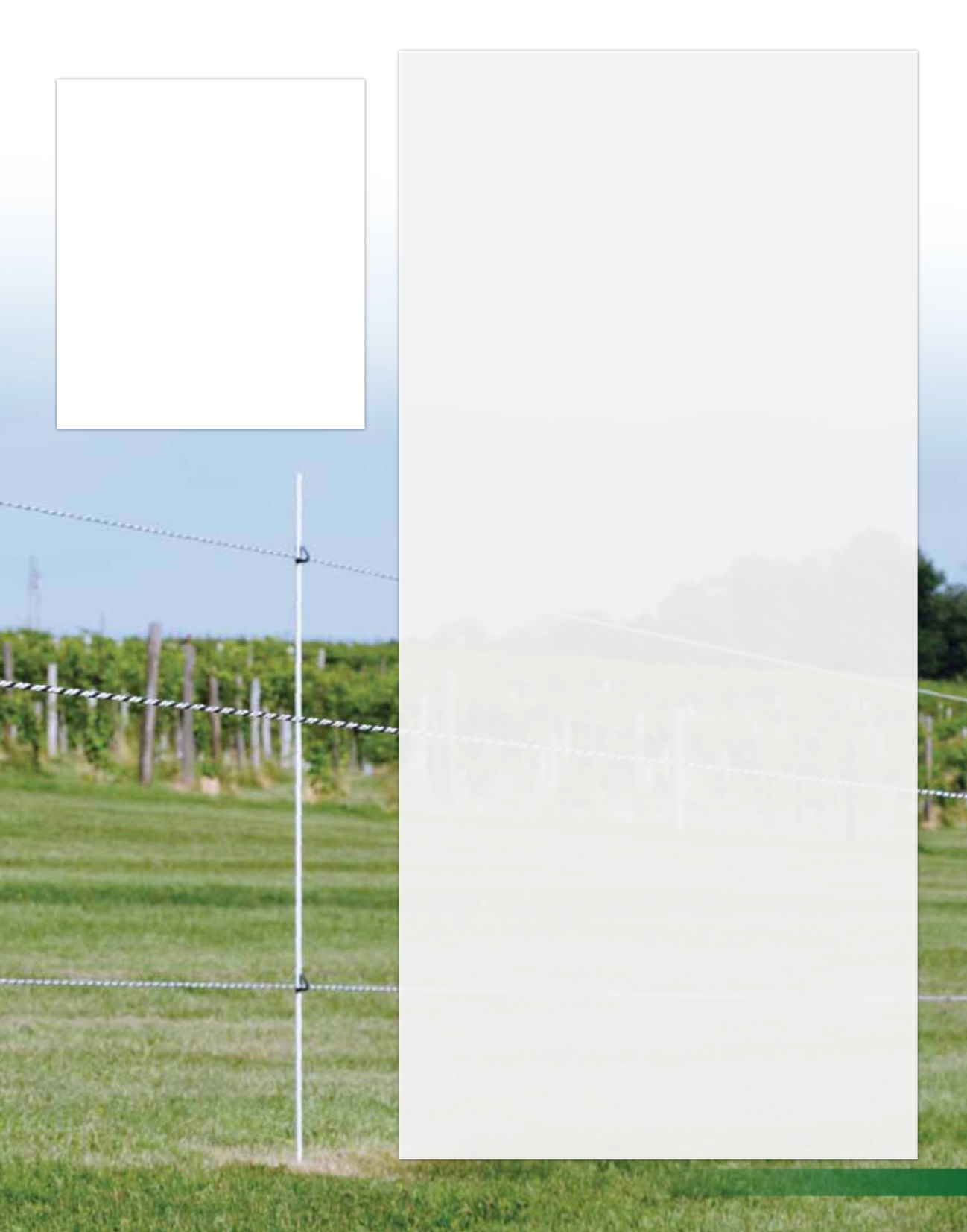 www.premier1supplies.com
www.premier1supplies.com
• 1-800-282-6631
WILDLIFE BARRIER FENCES 41
Fence is protecting the Fireside
Winery vineyard (Marengo, IA).
Why no clip on the middle strand?
It’s offset (3 ft) from the fence in the
background. This is part of our 3D
deer fence design (see pp. 56–57).
The only 100% deer barrier is an
8 ft tall woven wire fence or solid
wall—expensive and permanent.
An alternative is electrified fences.
They rely upon a painful shock to
persuade deer to neither jump nor
penetrate a fence.
Because they aren’t physical
barriers, electric deer fences rely
upon key deer behavior aspects.
1. Deer, like us, are creatures
of habit.
Where they choose to feed, rub,
walk and breed are habits learned
over time—a habit reinforced every
time they do it safely.
Suddenly fencing a deer herd
away from an area forces the herd to
break a habit. That is why the first
days of denial of use (by a fence) is
critical if the fence is to succeed.
Once a herd’s pattern is broken,
the change in feeding/walking
location is easier to maintain.
2. Deer make risk-benefit decisions
about feeding sites, trails and
rubbing trees.
Electric fences use pain to
raise the cost (the degree of risk
and effort to use an area) and
persuade deer that it is safer and
less frightening to feed, rub or trail
elsewhere. When they are desperate
they may risk the pain—which is
why you can’t keep out starving
deer with electric fencing if the site
is their only food source.
3. Electric fences work when deer
have time to make a decision to
avoid them.
That’s why it’s important to
identify deer trails entering a
new exclusion area and interrupt
them with something physical
(e.g. a brush pile) where the trail
approaches the fence. Do this when
the fence is installed.
Why? The trail change makes
them tentative. This makes them
move cautiously.
4. Don’t hunt near the fence.
Why not? Because frightened
deer don’t make normal decisions.
As prey animals they are easily
spooked into leaping over or
through fences. Once deer learn that
they can jump the fence without
Anti-Deer fences—
why some work & some don’t
Netting—
Temporary
•
VersaNet Plus 9/20/3................. pp. 44–45
•
VersaNet Plus 11/30/3...................... 46–47
• ElectroNet 9/35/12....................................48
Semi-Permanent
• RaccoonNet 4/18/12........................... 42–43
• New! Bear QuikFence 12/35/12.............49
• PermaNet Plus 12/48/3..................... 50–51
• VersaNet Plus 12/60/3....................... 52–53
• Deer QuikFence 5/60/12..........................54
• PermaNet
19/68/3&
12/68/6..................55
Multi Strand—
Semi-Permanent • Multi-Strand............................................. 58 Permanent • 3D Anti-Deer Fence........................... 56–57pain, they’re more likely to do so
when not frightened, a habit that’s
costly to break.
5. Fence a small area first.
Why? The intent is to first change
the herd’s habits. Install a new
fence around a small area first. The
local deer herd will encounter it,
learn to avoid it and instead feed or
rub in adjacent areas.
Leave it in place for 2 weeks.
Progressively expand the enclosed
area until 100% is protected.
6. Deer interpret a fence in their
own terms.
Their world is black, white and
shades of gray. Therefore,
barriers
that contrast with their view of the
world
are the most visible to deer—
and likely to get their attention.
It’s been our experience that deer
fences that fail are usually:
• Installed at the wrong time
(after habits have developed).
• Managed without an awareness
of how a deer herd interacts
with fences.
7. Use scent caps to train the local
deer herd.
• What are scent caps?
Metal
pop bottle caps attached to
the fence that are baited with
apple scent to attract deer. It’s
a Premier invention that’s been
copied by others.
(See p. 56.)
• How do they work?
Experience
has shown that apple scent
caps encourage deer to have
an initial painful interaction
with a new electric fence. The
scent entices deer to touch the
caps. The deer receive a shock
through their noses. (Peanut
butter also works but it’s not as
easy to apply.)
• How many caps?
One every 50
ft in heavy traffic areas (or 100 ft
in low traffic areas).
• Is it hard to rebait scent caps?
Baiting involves turning off the
energizer; walking or riding
along the fenceline; twisting
the cap upward, squeezing a
few drops of apple scent onto
the cotton inside the cap; and
twisting the cap downward.









